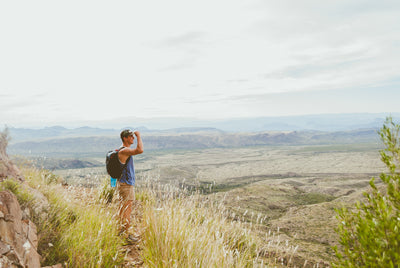Palette of the Bend
Kammok team member Lawton Cook writes about his first trip out to West Texas and why he can't help but go back for more.
• • •
"Finally, I wish to offer my opinion, just as a private visitor, that although the old saying that 'he who travels must be prepared to take away only as much as he brings with him' applies to all our great parks, it holds true especially of Big Bend. It is a desert-mountain country whose qualities offer an allurement, a satisfaction of soul, only if the visitor will put himself in the right mood, and will remain long enough to know it with some intimacy. He who drives in and drives out without letting the motor cool, may see, to be sure, some most interesting natural objects, but he will not know, and can never love, Big Bend."
-Freeman Tilden, 1945
When you love a place so much, it can be hard to reduce every inch of it into a few words. I’ve visited Big Bend regularly over the last five years, but I’ve written very little about those experiences. Where do you start in describing a place that has such a commanding hold on you? The task feels akin to describing every inch of your best friend and lining out their deepest secrets, personality traits, and physical features down to the very last hair on their head. I want to tell you of the long afternoons paddling through stunning canyons, passing a bottle of sotol around a campfire as the Rio whispers in the night, walking dusty desert trails at sunset and continuing on after dusk, and waking to stunning views from high in the Chisos Mountains as the sun rises blood red over the Sierra del Carmen.
I’ll just tell it how I remember it, the way I saw it for the first time. A few months after my wife and I were married in Austin in 2016, we were still living with a wonderful carelessness afforded by our lack of responsibility. No dogs, no kids, no obligations. We decided around 8 p.m. on a Friday evening that nothing was stopping us from driving seven hours to Big Bend for the long weekend, so we packed our Honda Civic and pointed west. It didn’t take too long for the endorphins to wear off, and the quiet slog of I-10 rumbled me to a sleepy stupor. We made it to Ozona before crashing in a roadside motel and then woke fresh the next morning and made for Fort Stockton. South of the I-10 turnoff in Fort Stockton, the Glass Mountains erupted from the Chihuahuan Desert like nothing else I’d seen in Texas. We stopped the car on the side of the highway so we could take pictures of these sub-6,000 foot peaks. Plenty of folks from the Mountain West, where 14ers mark the landscape, would be unimpressed by these lowlying mountains, especially given their inaccessible location on private land behind barbed wire fences, but I was blown away that such a place existed in my home state.
After spending a day in Alpine and Marfa, we finally rolled into the north entrance of the park well after dark and found a campsite at Rio Grande Village. The next morning we woke to the pale Chihuahuan Desert, everything dust covered and dry, begging for rain. We peered over the banks of the Rio to catch a first glimpse at the muddy river below, not knowing in just a few years time we’d be in those waters, pulling our paddles through the current as our canoes pushed forward into Boquillas Canyon. From above we could see a few locals from Boquillas del Carmen on the opposite side, lounging in the shade of the mesquites, waiting for their friend who was fording the river on a skinny horse to meet them. He’d placed an assortment of handmade desert trinkets on a rock for tourists to purchase—ocotillos, roadrunners, and other desert plants made from twisted wire and brightly colored beads—with an empty pickle jar as an honor system cash register. This was my first time to see our southern border, and the peacefulness of the place, the quiet hush of the river below the sun-baked desert, subverted all other notions I had about this controversial line in the sand.
When you live in a place all of your life, you get the feeling you know everything there is to know about it. But when you call a place as big as Texas home, you’ll soon find out driving across it that there’s much of it you’ve never seen—much of it you’ll likely never see. Not only that, but with opinions as big as the state itself, you also bring with you certain ideas and biases that don’t really bear out in truth. Like the idea that West Texas is all flat and brown, that mountains are far from home, and that the border is a place to fear. During that first visit to Big Bend, all my ideas about Texas were turned upside down. I kept asking aloud how no one had ever told me this place existed. How had I never, in all my 26 years in Texas, visited what I now believe to be the most exceptionally beautiful part of our state? It was a feeling of both incredible gratitude for being in the place and almost irritation for having not seen it sooner.
Those feelings were only amplified by my first drive into the Chisos. Amanda and I drove towards the basin and watched as candelilla and ocotillo gave way to blooming sotol plants, and as we rose, to vibrant junipers and pinyon pines. The mountains glowed all around, crags of rock that seemed to belong somewhere else. The view of the mountains from the road were enchanting—guaranteeing I would be coming back year after year. We snagged a campsite in the Chisos Basin campground, not knowing just how incredibly lucky we were to nab an open spot, and hiked the always classic Window Trail for the very first time. It seems like we stretched that hike into hours, stopping often to examine a plant we’d never seen before or take a picture of a new view. The Window itself was mind blowing, and although it's one of the more touristy places on the map, it remains one of my favorite trails in the park. I mean, how could it not?
That evening we shared our campsite with a couple who rolled in late without a reservation. They had a charcoal grill with them, almost like a fire pit, and we were grateful to have a warm blaze to sit around in the cool mountain air. We got to know each other over too much whiskey, and then retreated to our tents for one last view of the brightest stars I’d ever seen in my life. We wanted to do one last hike before making the drive back, but of course we woke late the next morning and didn’t have our campsite packed up until noon. A ranger at the visitor center mentioned Emory Peak when we went looking for advice, adding “But you really should have started earlier in the day. It’s about a six to eight hour hike, and it’ll be pretty hot. Bring plenty of water if you decide to go.”
I tried to persuade Amanda to do anything else, but her heart was set on climbing Emory Peak. Even if we absolutely crushed the hike, we were still looking at a seven hour drive on the other side with work the next day in Austin. When I told her we couldn’t do the hike she put on the most pitiful face of disappointment. In the end we continued the “what the hell” theme we started the trip with. Sure, we can drive to Big Bend in the middle of the night. If we can do that, surely we can knock out this awesome hike and make it back home at 3am. I’ll admit that I agreed to the plan pretty begrudgingly, but usually when Amanda drags me into something, it turns out to be pretty memorable.
The hike up Emory Peak and back is about ten miles. The park ranger told us to carry about a gallon of water each for the elevation gain and heat exposure, and I looked at our two Nalgenes with a feeling of complete inadequacy. Call it ingenuity or total noob move, but I bought a 2.5 gallon jug of water from the convenience store—the kind of jug with the spigot on one end and the handle on top—and strapped it to my Topo Designs Rover Pack for the long hike up. I don’t think Topo Designs would mind me saying this considering their pack was not designed to awkwardly carry a huge jug of water, but that was the most uncomfortable backpack I’d ever slung over my shoulders. It was like being in fourth grade again carrying a Jansport backpack crammed with every single text book, notebook, and pencil. Needless to say we invested in more appropriate gear after this adventure.
We made it to the top of Emory Peak on wobbly, unseasoned legs, but we made it nonetheless. At the end of the trail, we scrambled nervously up the small rock face to the summit and touched the survey marker like we were crossing a finish line. I didn’t know it at the time, but from the top of the Chisos Mountains, we were looking at Elephant Tusk down below across the Dodson Trail and Santa Elena Canyon beyond. To the southeast, the Sierra del Carmen range stood watching over Boquillas just across the Rio Grande, and to the north, Santiago Peak emerged among smaller mountains, pointing the way home. On that day five years ago I looked out at a place completely foreign to me, nameless in every way. A 360 degree view of a Texas I didn’t recognize, but one I couldn’t wait to get to know.
Five years later, I’m still no expert on Big Bend by any stretch. And in some ways, I enjoy that. I’ve been back for several paddle trips on the Rio and some hikes in the Chisos, and I still haven’t even scratched the surface of what this place offers. That means every time I go I get to put my boots in a new patch of dirt, learn something new, and be completely mystified. But I think if you asked someone who’d been going to Big Bend for a lifetime, they’d probably tell you they feel the same way.
Our Palette of the Bend print draws colors from South Rim views high in the Chisos where the first light of day paints Big Bend with such brilliant shades that you wish the sun would stop so you could take it all in just a little bit longer. Beyond that though, this print represents our inability to capture just how grand this place is, from the resilient desert to the mighty canyons and all the way to the top of Texas’s most glorious mountain range. It’s a place worth taking your time in—a landscape that demands your attention with all its wonder, causing you to sit in silence and disbelief. It’s a feeling worth leaning into. And every time you go back, hopefully you’ll be just as amazed by this place as you were on your very first visit.
Amanda and I hit the parking lot with exhausted legs and aching feet after a speedy hike down the Pinnacles Trail. We sank into our Honda Civic, kicking our shoes off on the floorboard and peeling off sweat soaked socks revealing ankles caked in trail dust. The sun set just as we passed the Persimmon Gap park entrance, and we felt pleasantly exhausted, proud of the adventure we’d chosen. We ate burgers in the Fort Stockton Dairy Queen before refueling with gas and heading east on I-10 for the long drive back, and we made it to our apartment in Austin at about 3am, ready to fall fast asleep after a job well done. Our first Big Bend trip was over, but we’d be back.
I’ll leave you with this quote from Freeman Tilden, who describes my feelings of Big Bend so beautifully and succinctly:
“Big Bend Park is the untamed, aloof, but never-ugly desert, with a whimsical river for deckle edge. Some folks say they do not like the desert. I wonder if they remained long enough to know? To me, the hours just before and after sunset, in this desert, in the shadow of the Sierra del Camens, when they redden to a deep crimson, and then fade to violet, with a finality of black velvet—and the moon comes rising behind the Chisos, and cleanliness and vastness enwrap everything—to me this is one of life’s moving experiences. Nobody really knows the desert who has not felt, seen, and surrendered himself to it, at dusk.”
It’s time to head out west.



